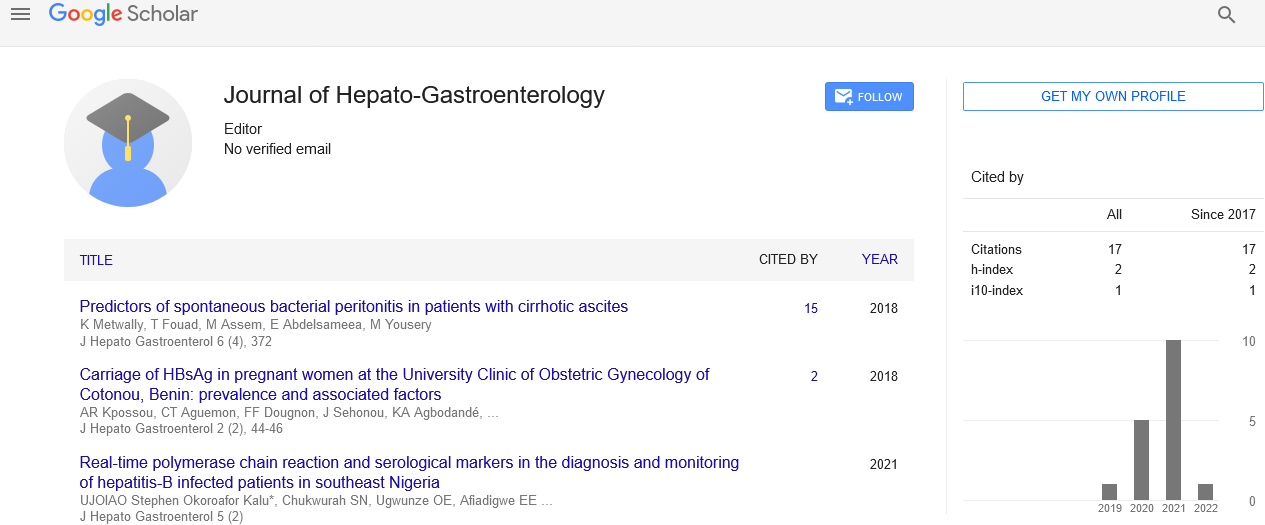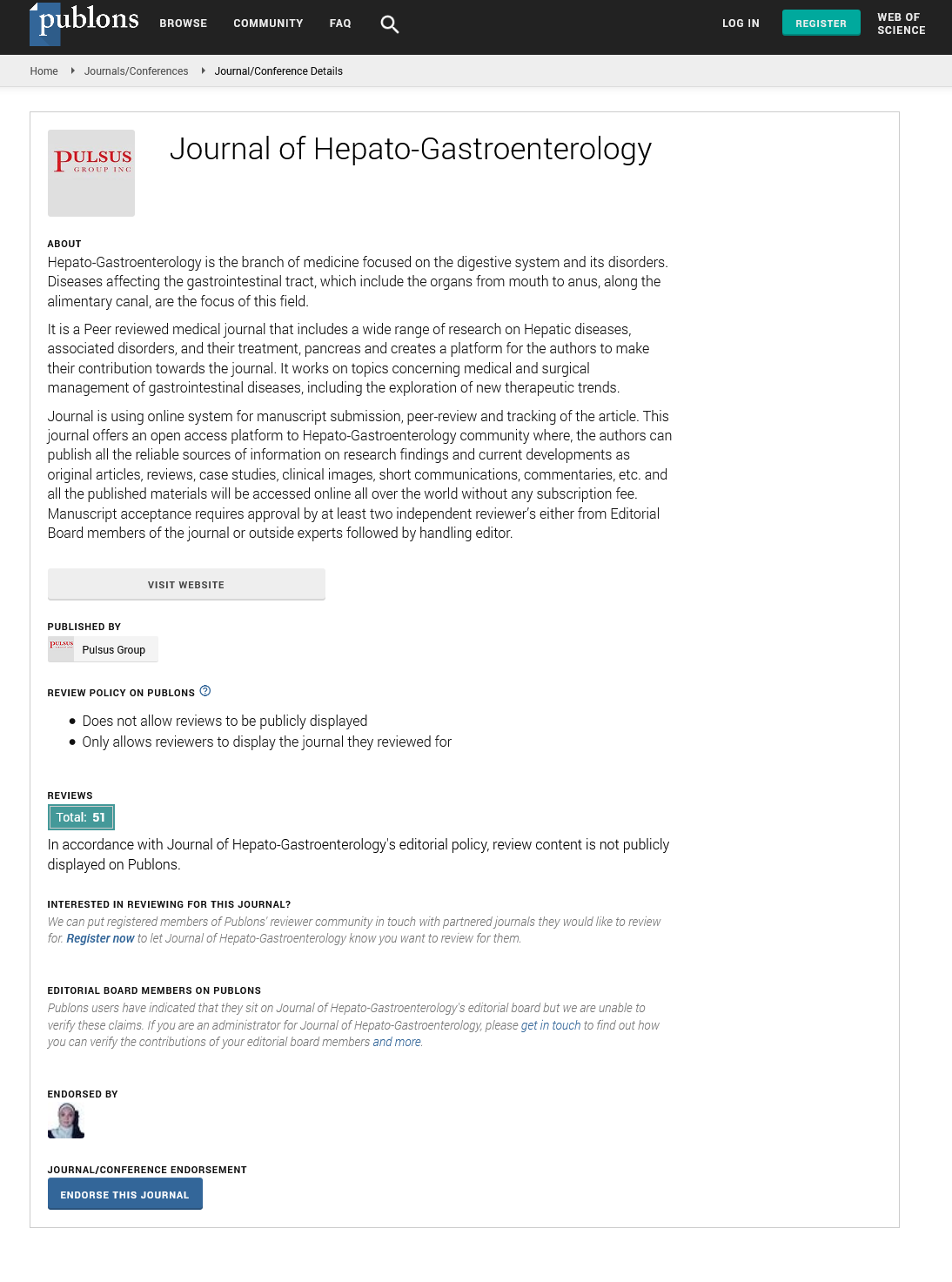Diagnosis of human cystic echinococcosis through serology and histopathology
Received: 19-Apr-2022, Manuscript No. PULHG-22-4784; Editor assigned: 21-Apr-2022, Pre QC No. PULHG-22-4784(PQ); Reviewed: 05-May-2022 QC No. PULHG-22-4784; Revised: 20-Jun-2022, Manuscript No. PULHG-22-4784(R); Published: 28-Jun-2022
Citation: Cooper E. Diagnosis of human cystic echinococcosis through serology and histopathology. J Hepato Gastroenterol 2022;6(3):0-1.
This open-access article is distributed under the terms of the Creative Commons Attribution Non-Commercial License (CC BY-NC) (http://creativecommons.org/licenses/by-nc/4.0/), which permits reuse, distribution and reproduction of the article, provided that the original work is properly cited and the reuse is restricted to noncommercial purposes. For commercial reuse, contact reprints@pulsus.com
Abstract
Hydatid infection is a significant arising ignored sickness around the world, with huge geographic variety in seroprevalance. The illness is regularly analyzed on premise of clinical doubt, imaging and serology. This review was directed to assess our involvement in serology in diagnosing hydatid sickness as far as recognizing the quantities of patients testing positive for antibodies against Echinococcus, and to concentrate on their clinical profile. This review incorporated all patients who tried for hostile to Echinococcus IgG antibodies by ELISA in the years 2011-2013. The clinical attributes of seropositive patients were stood out from seronegative patients, and the experimental outcomes were associated with radiological discoveries and, where performed, with histopathological studies. Investigation was performed on SPSS. Out of 31 patients assessed by serology for Echinococcosis during the review time frame, 7 (22.58%) were seropositive. Liver was the most regular site included (24 patients; 77.77%). Second organ the lung 5 (16.13%) bone 1 (3.23%) and the optic 1 (3.22%). Of the 29 patients who additionally went through biopsy, every one of the seven patients with positive biopsy were seropositive, recommending 100 percent awareness. The particularity was 83.33%, however this may be a lower gauge because of possibly high pace of bogus negative biopsies, as every one of the seropositive patients additionally had imaging highlights reminiscent of illness. The positive and negative prescient qualities were 77.77% and 90.90%, separately. ELISA for discovery of anti Echinococcus antibodies is a basic serological test that assists in connection with imaging finding in the conclusion and ensuing administration of hydatid sickness.
Keywords
Echinococcus, Seroprevalance, Hydatid sickness
Introduction
The illness shows up as numerous strong, cancer like sores growing on the inside and outside of the organs. The pimples can go in size from 2 to 20 cm, are loaded up with liquid and can contain numerous more modest, little girl growths cystic echinococcosis is universally appropriated and seen as in each mainland aside from Antarctica and furthermore with the exception of Iceland and Greenland; The illness is described by a practically overall dispersion causing critical horribleness and extensive financial effect in exceptionally endemic areas; Significantly lessening meat and milk creation as well as causing ripeness misfortune in animals. It is particularly predominant in pieces of Eurasia, north and east Africa, Australia, and South America, communities that training sheep cultivating experience the most elevated chance to people be that as it may, wild creatures can likewise fill in as a road for transmission. For instance, dingoes fill in as an authoritative host before hatchlings contaminate sheep in the central area of Australia.. Sled canines might uncover moose or reindeer to E. granulosus in pieces of North America and Eurasia. The rate in clinics is multiple times not exactly the pervasiveness as just a little extent of patients who foster extreme side effects looks for clinical consideration. According to the proposal by the World Health Organization, emergency clinic information can be utilized to gauge the commonness of CE in a populace. The presence of these separated cases in man which isn't exactly typical transitional host for the hydatid blister yet at the same time having our regard for the significance of hydatid pimple, which could be considered as that happens in wild creatures which are turning out to be somewhat more significant as that to human wellbeing.
The richness of blisters is a significant component that can impact the transmission of E. granulosus. Contingent upon the idea of contaminated has and the locales of disease, pimples might have different richness rates. These pimples usually happen in the lungs and liver, yet can be found in some other organ or tissue including bones, spleen, heart, eye, cerebrum, and genitourinary lot. Anatomo clinical changes are exceptional to confinement in the bone. From the anatomopathologic angle, this restriction denotes the lethargic, guileful movement of the parasite into the bone tissue, prompting a diffuse, broad, intrusive cycle; so from the clinical point of view, any place it is limited, its finished careful destruction is seldom conceivably.
The lifecycle of E. granulosus includes canines and wild carnivores as a conclusive host for the grown-up tapeworm. Conclusive hosts are the place where parasites arrive at development and duplicate. Wild or tamed ungulates, like sheep, fill in as a halfway host advances between life stages happen in middle hosts. The larval stage brings about the development of echinococcal sores in middle of the road has. Echinococcal blisters are slow developing yet, can cause clinical side effects in people and be hazardous. Cysts may not at first reason side effects, at times for a long time. Side effects created rely upon area of the pimple, however most happen in the liver, lungs, or both. When tainted squander is discharged into the climate, moderate host can possibly get the parasite by brushing in defiled field, propagating the cycle. Granulosus is communicated from the transitional host (sheep) to the conclusive host (canines) by incessant taking care of offal, likewise alluded to as "assortment meat" or "organ meat". Consuming offal containing E. granulosus can prompt contamination; in any case, disease is subject to many variables.
Conclusion
Serology for identification of antibodies against hydatid infection is rarely used. In any case, it is a straightforward test to affirm the finding, and ended up being hearty as far as we can tell, with 100 percent responsiveness when contrasted and imaging as well as histopathology. The determined particularity of 81.8% when contrasted with biopsy is reasonable an error, as serology results associated with imaging endings in the seropositive patients in general.






